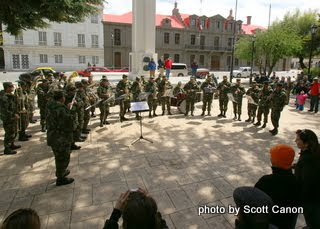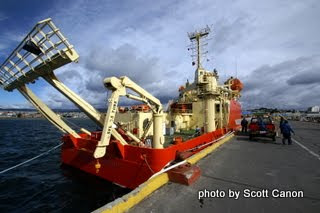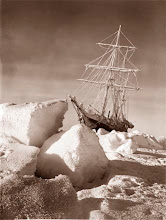One last run through our South American staging ground.
Unlike so much of the world, the homogenizing taint of U.S. franchises – McDonald’s, KFC and Pizza Hut in particular seem so common everywhere else – has yet to invade the southern tip of Chile.
More than a few shops catering to tourists and locals trade in the hiker chic brands like North Face and Columbia. (Oddly, though, I don’t think I ran across signs for Patagonia clothes, which is named for the region.)
But still, there are places that would fit in nicely en Los Estados Unidos. Consider Lomit’s (alternately described on its menus as the more Latin Lomitos). It could substitute nicely for Chicago’s Billy Goat Tavern, a watering hole and grill long popular with that city’s newsfolk dating back to the age of Royko. Middle aged readers will remember it as the place that inspired early “Saturday Night Live” skits with Dan Akroyd and John Belushi bullying their customers in thick Balkan accents about “cheeseburger, cheeseburger, no fries – chips!”
The staff at Lomit’s doesn’t come on as strong, but they dish up a deliciously greasy burger smothered in a muenster-like cheese. The sandwich is the size of your face – unless you’re John Kerry. The meal is best washed down with Austral Calafate Ale – named for the native calafate berry that turns it slightly sweet and crimson – straight from the southernmost brewery in the world.
It doubles as a sports bar, and the folks were watching a game Sunday afternoon that had something to do with a ball. But I was left clueless because there was no hoop or bat or Chiefs massacre.
Along the cold windy beaches, as much rock and seawall as sand in many places, young couples like to huddle tightly together in twosomes. I guess it’s one way to keep warm.
At the town square, it was as if John Phillip Souza had imposed his will on a Latin jazz band. A mix of army and naval troops marched through the main drag and assembled for a mini-concert at the town square. They improved tremendously when they stopped marching and swapped in more salsa for the Souza.
Later I would do my own marching, spending a few hours cruising for a pharmacy that was open, carried seasickness pills and could understand my use the word vomito. Not easy on a Chilean Sunday.
I stumbled across what seems a ritual on Sundays for families to make to trek to tightly packed two-story mausoleums. Maybe long cold winters led people this way rather than waiting until spring to bury the dead.
 Although the crew, Crean especially, took a fondness to the dogs, the huskies could be a nasty pack prone to chomping on the hands of their handlers. But they were critical to early 20th century polar expeditions. Attempts to use gas- or diesel-powered tractors proved disastrous. And ponies, it turns out, even when fitted with pony snow shoes (no kidding) are much better for birthday parties than crossing the ice.
Although the crew, Crean especially, took a fondness to the dogs, the huskies could be a nasty pack prone to chomping on the hands of their handlers. But they were critical to early 20th century polar expeditions. Attempts to use gas- or diesel-powered tractors proved disastrous. And ponies, it turns out, even when fitted with pony snow shoes (no kidding) are much better for birthday parties than crossing the ice.




































